The 2014 Meeting of the International Clematis Society in the USA
This is the third of my informal reports about the visit by the Society to the USA in May/June 2014. A comprehensive set of articles by attendees will be published in Clematis International 2015 but here I’ll give you my personal perspective of the event, in particular looking beyond the clematis as well as at them.
Part 3 – Philadelphia, Pennsylvania
Sunday 1st June – Arrival in West Chester

Having been on the pre-meeting visit to Georgia, we only had a short flight to Philadelphia airport. The cab ride to West Chester was slightly longer than expected, a bit over one hour so I remember, but heavy traffic didn’t help. Interestingly, the return cab ride at the end of the week was barely 40 minutes, but then the cab driver was local and knew a scenic and traffic back route. Local knowledge definitely counts!
The Warner Theatre was opened by the film company, Warner Brothers, in November 1930. The classic Art Deco design was both modern and stylish, and quite a boost for the town of West Chester. It continued as a movie theatre through to the 1970’s, when it was renovated and turned into a venue for live performances.
By the mid 1980’s its usage had declined and the city council agree to its demolished. The main auditorium was taken down but the frontage was retained, to be used as offices. Then in 2011 a plan was proposed to turn the building into an hotel, retaining the frontage whilst building modern facilities on the back. The result is as you see it today, a magnificent art deco entrance, complete with grand staircase, but with modern spacious guest rooms.
Just round the corner from the main high street in West Chester, it was a great location for us.
Monday 2nd June – Mill Fleurs
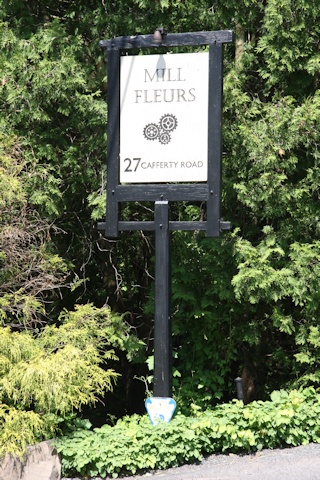
Our first Pennsylvania visit was Mill Fleurs, for the garden of Barbara and Robert Tiffany. Originally a grist mill and saw mill, Barbara and Robert bought the site, in what was quaintly described as a “rustic” condition, in 1993. For three years they laboured to renovate the buildings and garden so that they could live here, and the work continues even today. But they have taken a very difficult site and turned it into a great garden. The site slopes down to the river and so has been landscaped heavily to allow a series of paths with beds either side, with the stone buildings of the old mills and other barns make great backgrounds.
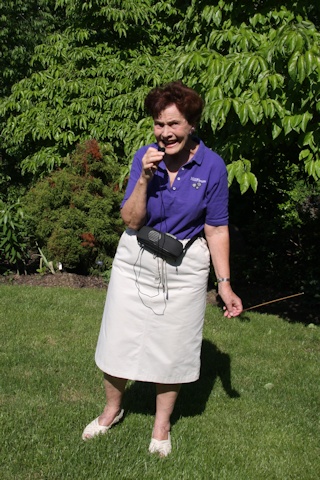
Barbara and Robert design and manufacture outside furniture, a number of examples were to be seen around the garden. They use a very striking design, which they call the Spirit Song Collection, to me creating a strong shape but also quite soft due to the sweeping curves. The chairs and benches were amazingly comfortable. Barbara gave a short introduction and then let us wander, staying around to answer questions. Whilst much of her planting uses shade loving plants (for obvious reasons), as she describes them – “woodlanders” – in particular hosta and epimedium though with many other examples, but she also uses clematis. We appreciated the garden maps provided showing the locations of clematis, and which was where. We also enjoyed coffee, cakes and fruit served on the roof area of one of the stone mill buildings.
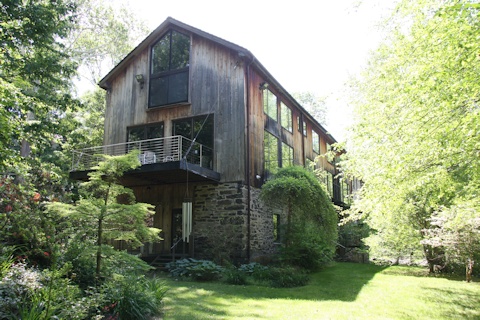
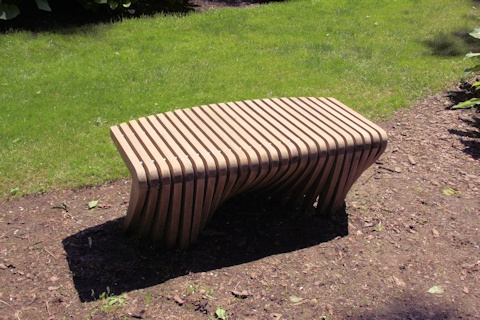

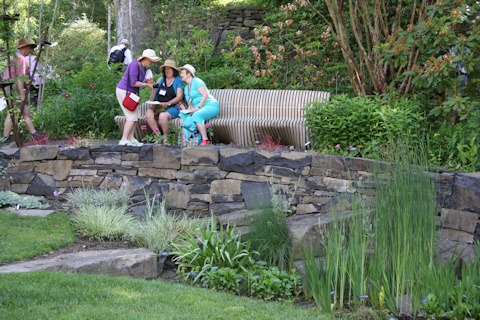
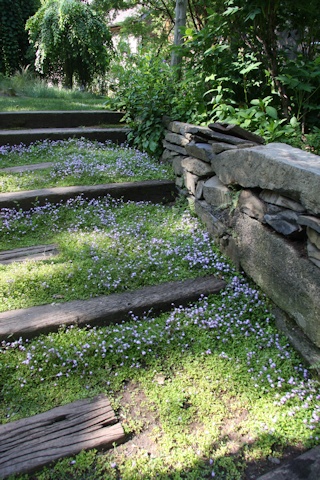
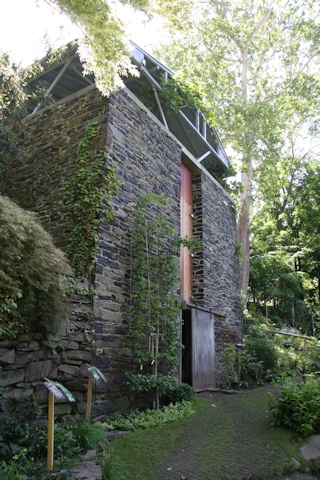
In spite of the steep slopes, Barbara has made an amazing garden, with many different areas with different planting themes.
New Hope, PA or Lambertville, NJ for lunch?
Lunch today was on your own with a choice of which state you favoured. You could either eat in New Hope, Pennsylvania, or cross the bridge over the Delaware river to Lambertville, New Jersey. Well, since the bus let us off in PA, Fiona and I just had to go over the water to the other side. It was interesting to see turtles sunning themselves on the concrete around the bridge supports. Both towns are pretty and quaint, perhaps a little touristy in parts but attractive veranda clad houses and interesting small shops. There was plenty of choice for eating and the word when we all reconvened to reboard the bus was that just about everyone had found something to please.
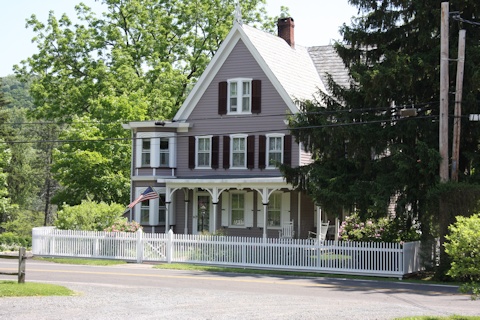
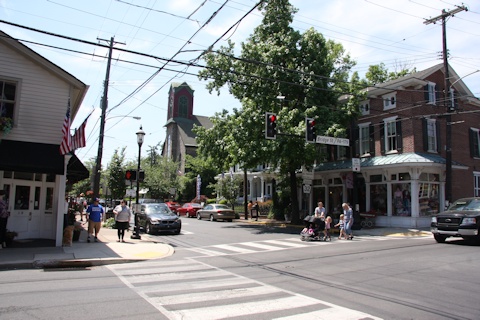
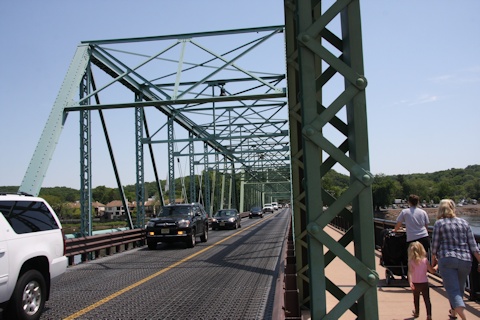
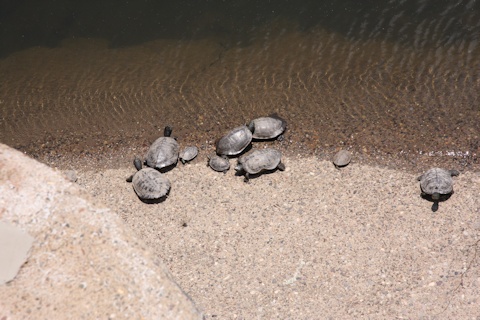
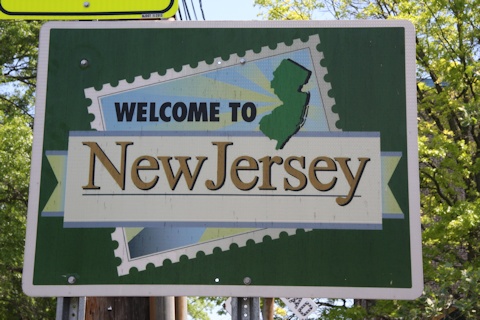
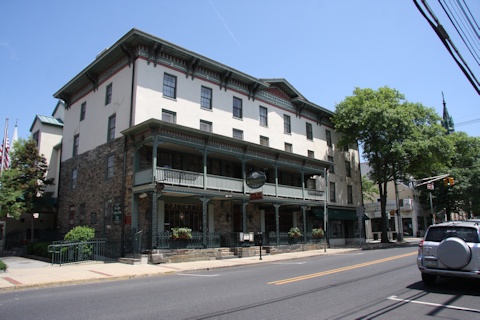
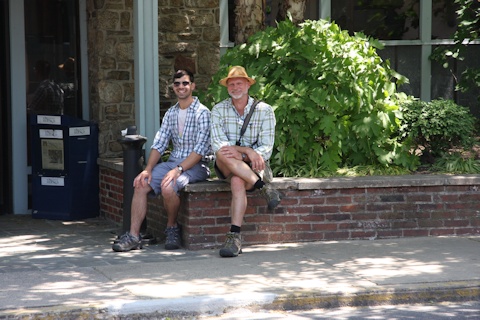

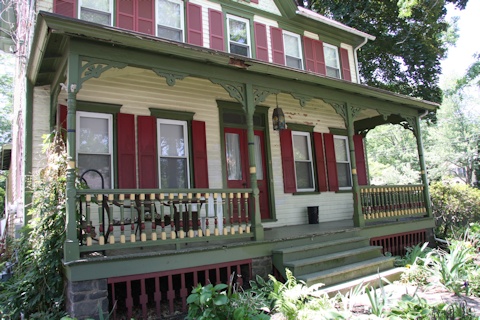
Hortulus Farm Garden and Nursery

The afternoon was given over to a visit to Hortulus Farm Garden and Nursery, an amazing 18th century “farm house” – more a substantial mansion to me – surrounded by some 30 acres of gardens. The owners, Renny Reynolds and Jack Staub, use it to show off their large collection of rare and unusual plants, which they also sell in the nursery.
There are many walks through the gardens and we were given an informal conducted tour. The grounds and fabulous, very varied themes in the different areas, some relatively formal but many quite casual in their design and implementation. But there was obviously a lot of love, care and attention given to all parts.
There were also some unexpected surprises, such as the beautiful white summer house in the middle of a large lake, looks very serene and the exotic fowl that they keep.
The weather had been sunny and hot all day, so the refreshments at the end of our tour were very welcome. We thank Renny and Jack for sharing their idyllic home and gardens.






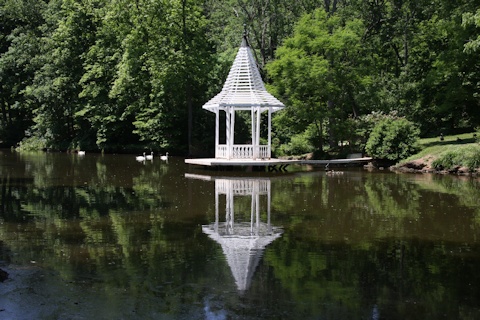
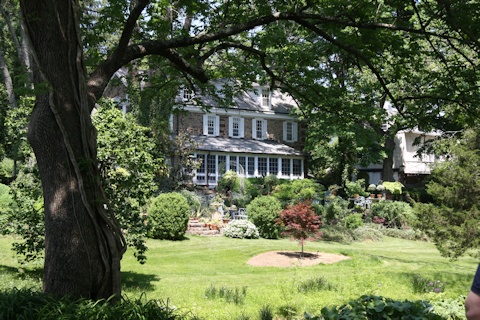
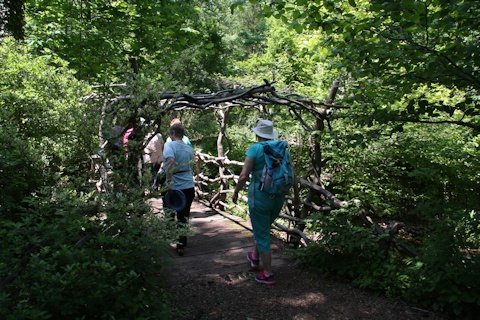
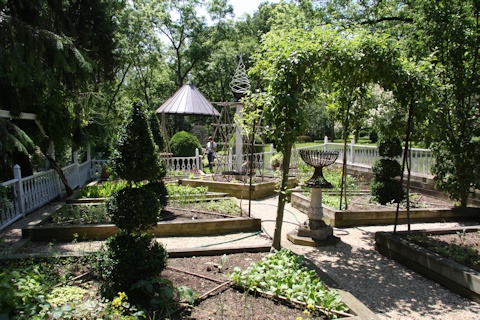
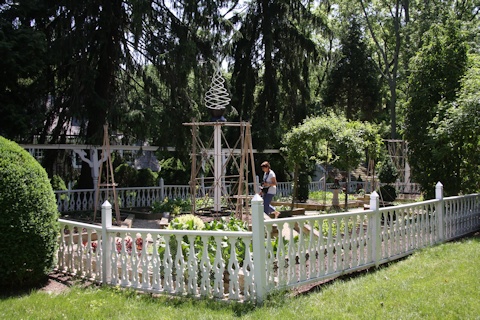
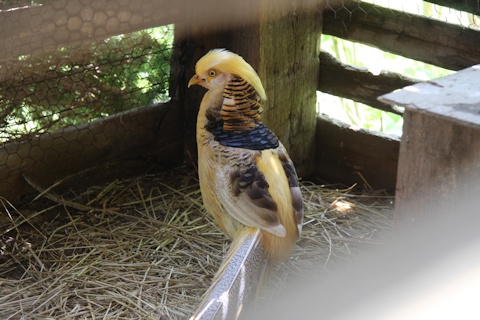
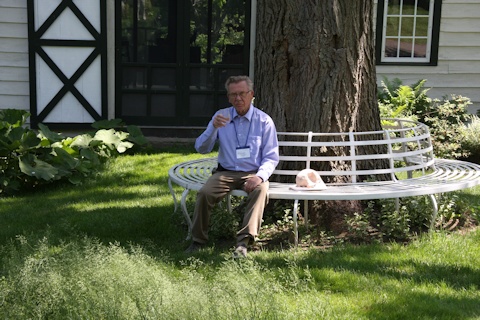
Victory Brewing Company
That evening we dined at the Victory Brewing Company, a micro brewery and restaurant in Downingtown, quite close to West Chester. The evening started with a beer tasting with matching canapés followed by dinner with accompanying beers. I think it’s fair to say a most enjoyable time was had by just about all!

Tuesday 3rd June – New York and the High Line
An early start on Tuesday, 7:00 a.m., though we still managed to get some breakfast thanks to the staff at the Hotel Warner. However there wasn’t time for me to make my usual fresh waffles in their semi-automatic waffle machine. Perhaps these are a common feature in US hotels, but I found it both fascinating and very satisfying to use as the automatic timer ensures perfectly cooked waffles every time.
Destination today, and the reason for the early start, is New York, specifically the lower Manhattan meat packing district. The early start definitely pays off as we have a surprisingly good journey with relatively little traffic. We catch a number of glimpses of the New York skyline, and in particular One World Trade Center (previously known as the “Freedom Tower”), erected on the site of the destroyed World Trade Center.
The High Line was originally an elevated railway serving the Manhattan meat packing district, bringing goods to and from the area. It was built in the 1930s and in use until 1980. Destined for demolition, it was saved by community action and has been transformed into an elevated public park. Admittedly it’s quite a “thin” park, often not more than, perhaps, 10 metres wide (30 feet) but about 1.6 Km (1 mile) long. It traverses this area of New York at 10 metres (30 feet) above street level, giving a unique perspective and a quiet and tranquil atmosphere on the busy city.
Personally I was looking forward to this visit, having read up on the High Line, it’s history and story of creation. The reality of it easily exceeded my high expectations.
To walk through New York at this elevation is a somewhat surreal experience and something I certainly haven’t done before. Quite a lot of railway track has been left in situ, and alone the park there are sculptures and decoration made from railway related objects, for example “point frogs” (a technical term, they are the sort of triangular bits of steel where two rails join).The planting was designed by Piet Oudolf of the Netherlands. So far two sections have been completed and work continues on a third. I’ll let the pictures do the talking, but suffice to say, should you be in New York I cannot recommend a visit more highly. It is unique and beautiful – and free!
There are a number of places along the High Line where one can enter and exit, but one of the most popular is Chelsea Market, a haven of small food and drink providers. The building used to be the National Biscuit Company factory, so it has a food heritage. Today, just about every ethnic variety of food is available here, mainly as take-outs but there are places to sit and eat. It is very popular with both tourists and locals alike, and gets very busy at midday when the local office workers come to get their lunch. All the food is prepared fresh, you order and wait until it’s ready but the turnaround is such that the wait is usually quite short. And the food is amazing!
 New York Skyline and One World Trade Center (Freedom Tower) |  One World Trade Center (Freedom Tower) |
 Map of High Line |  Entrance to High Line |
 Climbing up to the High Line |  Our first view of the High Line |
 There are still railway lines in many places |  Railway themed art |
 A peaceful park in the heart of New York |  Interesting planting amongst the railway lines |
 Chionanthus virginicus (White Fringetree), a native of eastern USA |  Discussing the planting |
 Glimpses of New York |  Frank Gehry designed IAC building |
 Planting amongst the rails |  Ceratostigma plumbaginoides (Hardy Blue-flowered Leadwort) |
 Railway “Points Frog” Sculpture |  Park maintenance |
 Current end of the High Line |  Strolling back |
 Chelsea Food Market |  A distant view of the Statue of Liberty |
Brooklyn Botanic Garden
Our afternoon destination was Brooklyn Botanic Garden. However, whilst the morning had been sunny and quite warm, by the afternoon it was, for me at any rate, hot, airless and rather oppressive and a bit unfortunate as it definitely detracted from the visit. It meant that the first thing one did was seek out shady areas – but that in itself wasn’t such a bad thing since we found ourselves in the Native Flora Garden.
Speaking for myself, I don’t feel I did the Brooklyn Botanic Garden full justice, with the exception of the Japanese Hill-and-Pond Garden. I have a particular liking for oriental gardens and was keen to explore this one. Originally created in 1914 / 1915 by the Japanese landscape designer, Takeo Shiota and restored in 1999 / 2000, it comprises a large pond with paths winding their way around the water. Coupled with bridges, viewing pavilion, stone lanterns and a Torii or Japanese gateway. The closeness of water, particularly the waterfall, and the shade of the overhanging trees meant that this garden provided a very pleasant environment in spite of the relentless sun.
 Native Flora Garden – nice and shady | |
 Sweet Gum tree (liquidambar styraciflua) planted in 1912 |  Commemorative Plaque |
 Unnamed clematis |  Clematis ‘Kathleen Wheeler’ |
 Ornamental pond |  Japanese garden – Torii |
 Japanese Garden – Stone Lantern |  Japanese Garden – Stone bridge with Torii in background |
Dinner with the King of Prussia!
Due to the distance we had to travel, we dined en route back to West Chester, at Season’s 52, a grill restaurant in King of Prussia. According to information I found on the web, the town was originally called Reeseville after the family who owned much of the land in the area. However they also owned a tavern called the King of Prussia Inn and gradually this name moved into common usage.
It had been a long day so to sit in a very comfortable restaurant and be served an excellent dinner was the perfect end to a perfect day.
For the fourth installment, continuing our time in Pennsylvania, please click Part 4.